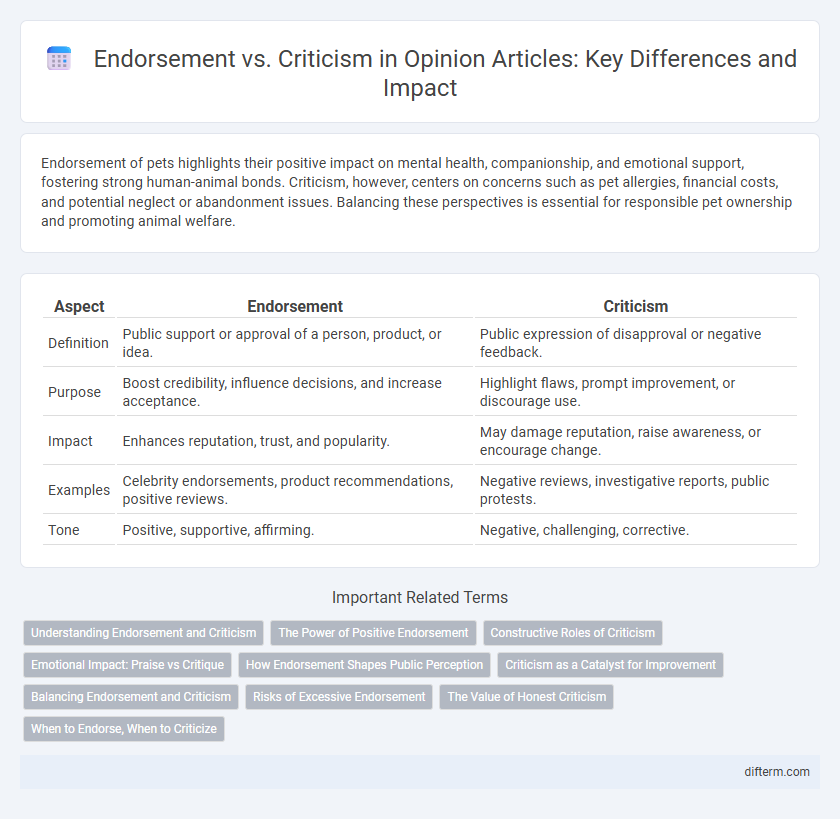Endorsement of pets highlights their positive impact on mental health, companionship, and emotional support, fostering strong human-animal bonds. Criticism, however, centers on concerns such as pet allergies, financial costs, and potential neglect or abandonment issues. Balancing these perspectives is essential for responsible pet ownership and promoting animal welfare.
Table of Comparison
| Aspect | Endorsement | Criticism |
|---|---|---|
| Definition | Public support or approval of a person, product, or idea. | Public expression of disapproval or negative feedback. |
| Purpose | Boost credibility, influence decisions, and increase acceptance. | Highlight flaws, prompt improvement, or discourage use. |
| Impact | Enhances reputation, trust, and popularity. | May damage reputation, raise awareness, or encourage change. |
| Examples | Celebrity endorsements, product recommendations, positive reviews. | Negative reviews, investigative reports, public protests. |
| Tone | Positive, supportive, affirming. | Negative, challenging, corrective. |
Understanding Endorsement and Criticism
Endorsement reflects positive recognition and support, often boosting credibility and trust in a person, product, or idea by highlighting strengths and benefits. Criticism offers evaluative feedback that identifies weaknesses or areas for improvement, which can foster growth and accountability when delivered constructively. Understanding endorsement and criticism helps balance affirmation with constructive insights, essential for informed decision-making and continuous development.
The Power of Positive Endorsement
Positive endorsement significantly influences public perception by reinforcing trust and credibility in a subject or individual. Endorsements from respected figures generate a ripple effect, inspiring confidence and motivating others to align with the promoted values or products. This affirmative reinforcement often drives stronger engagement and loyalty compared to criticism, which can sometimes trigger defensiveness or disengagement.
Constructive Roles of Criticism
Criticism plays a crucial constructive role by identifying weaknesses and offering actionable feedback that drives improvement and innovation. Unlike mere endorsement, criticism encourages deeper analysis and fosters resilience by challenging assumptions and promoting growth. Effective criticism cultivates a culture of transparency and continuous development within organizations and creative endeavors.
Emotional Impact: Praise vs Critique
Praise generates positive emotions such as joy and motivation, reinforcing confidence and encouraging continued effort. Critique often evokes feelings of defensiveness or discouragement but can also stimulate growth when delivered constructively. Emotional impact shapes how individuals internalize feedback, affecting their response to endorsement or criticism.
How Endorsement Shapes Public Perception
Endorsement significantly shapes public perception by providing credibility and social proof that influences consumer trust and decision-making. Celebrities and experts who endorse products or ideas amplify positive associations, resulting in increased acceptance and adoption. The emotional connection fostered through endorsements often eclipses logical criticism, reinforcing favorable opinions more effectively.
Criticism as a Catalyst for Improvement
Criticism acts as a powerful catalyst for improvement by highlighting specific flaws and areas for growth, enabling individuals and organizations to refine their strategies and enhance performance. Constructive feedback, when embraced with an open mindset, drives innovation and fosters resilience by transforming challenges into opportunities for development. Unlike mere endorsement, criticism provides actionable insights that propel continuous learning and measurable progress.
Balancing Endorsement and Criticism
Balancing endorsement and criticism requires recognizing the value of both in fostering growth and maintaining credibility. Expressing endorsement bolsters motivation and highlights strengths, while constructive criticism drives improvement by addressing weaknesses. Mastering this equilibrium enables more effective communication and decision-making across personal and professional contexts.
Risks of Excessive Endorsement
Excessive endorsement can create unrealistic expectations and diminish critical evaluation, leading to poor decision-making and potential loss of credibility. When endorsements overshadow objective analysis, individuals and organizations risk overlooking flaws and limitations. This imbalance often results in diminished trust from stakeholders and increases vulnerability to unforeseen negative consequences.
The Value of Honest Criticism
Honest criticism offers invaluable insight that fosters growth and improvement by highlighting genuine flaws and areas for development, unlike mere endorsements that may overlook crucial challenges. Constructive feedback rooted in honesty cultivates trust and encourages deeper self-reflection, ultimately leading to more meaningful progress. Embracing candid opinions strengthens decision-making processes and drives authenticity in both personal and professional spheres.
When to Endorse, When to Criticize
Endorse when ideas or actions clearly align with core values, demonstrate positive impact, or promote constructive progress to reinforce credibility and support growth. Criticize when actions contradict ethical standards, cause harm, or impede progress, using specific, fact-based feedback to encourage accountability and improvement. Balancing endorsement and criticism requires assessing intent, outcomes, and the potential to foster dialogue without diluting the message's integrity.
endorsement vs criticism Infographic

 difterm.com
difterm.com